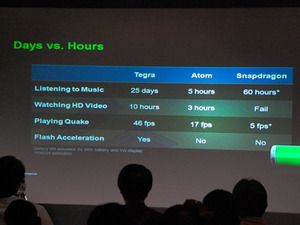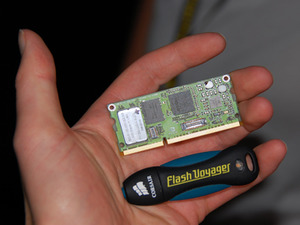Today Nvidia’s CEO Jen-Hsun Huang delivered his company’s second Computex address in as many days. Today’s speech was a much more focussed affair than the first – which rambled from ambitious plans for Ion to providing free 3D glasses.
This time, the whole speech focussed on one product: Tegra. It’s a complete ‘system on a chip’ which is barely bigger than a USB thumb drive. Huang called it “one of the most ambitious investments in the history of our company”, and said it has cost Nvidia $500 million and taken over five years to design.
Although Nvidia has talked about Tegra before, this is the first time the company has clearly laid out its aims for the chip and shown off computers which will actually use it.
Tegra has been designed to be frugal with power, with Huang reasoning that “it’s very clear that the reduction in power consumption is what enabled progress from mainframes to PCs to laptops.” According to Nvidia, reducing power by a factor of 100x is what is required to enable designers to create new form factors.
Current high-end gaming PCs can easily draw 500W from the wall (we once had a Vadim machine that managed a scintillating 750W), with laptops taking this figure down to around 20W. Tegra, Nvidia claimed, was designed to use “no power”, although when Tegra General Manager Mike Rayfield took to the stage, he did revise this figure to 1W.
Still, 1W is a lot less than current PCs use, and judging by the onstage demos, it’s a capable chip. Rayfield showed a Tegra unit smoothly playing a 720p trailer for the new Star Trek movie, and browsing Flash-heavy websites.
Tegra features eight independent processors – listed as an Arm 11, an Arm 7, a GPU, a 2D engine, a HD video encoder, a HD video decoder, and Audio and Imaging. According to Nvidia, it achieves its low power usage as it has a processor for each job, and when a processor isn’t being used, it stays powered down.
Huang made an interesting point when he compared the way people use PCs and their mobile phones – the PC is generally powered up when needed, while phones are left on all the time. His claim was that Tegra’s design was frugal enough with power that with a ‘netbook-style’ battery it could be used in a similar manner to a phone – left on and always at your disposal.
A slide then showed a Tegra system’s battery life compared to an Intel Atom machine, and one based on Snapdragon, Qualcomm’s low-power chip. Unsurprisingly, Tegra came out of it rather well, offering 25 days of music playback compared to 5 hours on Atom and 60 hours on Snapdragon. Nvidia claimed Tegra coule play Quake at 46fps, and 10 hours of HD video versus three hours for Atom. Snapdragon was awarded a ‘fail’ mark in this category.
After all the talk, Nvidia then finally showed several different Tegra systems – some were similar to netbooks, others were even smaller. Inventec and Mobinova both had machines with 10.1in displays with a 1,000 x 600 resolution, while the ICD Ultra was a 7in machine with a capactive touch screen. The exact models available will vary from country to country, but Nvidia told bit-tech that it expects the first wave to be in stores before the end of the year and that initially they will be sold, in Europe at least, by mobile phone carriers on 3G data contracts.
Nvidia’s plans are nothing if not ambitious – Huang may have officially signalled the end of the company’s interest in motherboards when he said “we have four brands – GeForce, Tegra, Tesla and Quadro", and then went on to stake out a bright future for Tegra:
"We believe that when we can bring computing power down to less than 1W we can open up the industry to billions of platforms. You car will turn into a computer, your TV will, your picture frame will, your clock radio will. Everything will have a computer inside it."
The proof, of course, is once the final hardware is actually out and in the hands of consumers. Until then you can discuss Tegra in the forums.


This time, the whole speech focussed on one product: Tegra. It’s a complete ‘system on a chip’ which is barely bigger than a USB thumb drive. Huang called it “one of the most ambitious investments in the history of our company”, and said it has cost Nvidia $500 million and taken over five years to design.
Although Nvidia has talked about Tegra before, this is the first time the company has clearly laid out its aims for the chip and shown off computers which will actually use it.
Tegra has been designed to be frugal with power, with Huang reasoning that “it’s very clear that the reduction in power consumption is what enabled progress from mainframes to PCs to laptops.” According to Nvidia, reducing power by a factor of 100x is what is required to enable designers to create new form factors.
Current high-end gaming PCs can easily draw 500W from the wall (we once had a Vadim machine that managed a scintillating 750W), with laptops taking this figure down to around 20W. Tegra, Nvidia claimed, was designed to use “no power”, although when Tegra General Manager Mike Rayfield took to the stage, he did revise this figure to 1W.
Still, 1W is a lot less than current PCs use, and judging by the onstage demos, it’s a capable chip. Rayfield showed a Tegra unit smoothly playing a 720p trailer for the new Star Trek movie, and browsing Flash-heavy websites.
Tegra features eight independent processors – listed as an Arm 11, an Arm 7, a GPU, a 2D engine, a HD video encoder, a HD video decoder, and Audio and Imaging. According to Nvidia, it achieves its low power usage as it has a processor for each job, and when a processor isn’t being used, it stays powered down.
Huang made an interesting point when he compared the way people use PCs and their mobile phones – the PC is generally powered up when needed, while phones are left on all the time. His claim was that Tegra’s design was frugal enough with power that with a ‘netbook-style’ battery it could be used in a similar manner to a phone – left on and always at your disposal.
A slide then showed a Tegra system’s battery life compared to an Intel Atom machine, and one based on Snapdragon, Qualcomm’s low-power chip. Unsurprisingly, Tegra came out of it rather well, offering 25 days of music playback compared to 5 hours on Atom and 60 hours on Snapdragon. Nvidia claimed Tegra coule play Quake at 46fps, and 10 hours of HD video versus three hours for Atom. Snapdragon was awarded a ‘fail’ mark in this category.
After all the talk, Nvidia then finally showed several different Tegra systems – some were similar to netbooks, others were even smaller. Inventec and Mobinova both had machines with 10.1in displays with a 1,000 x 600 resolution, while the ICD Ultra was a 7in machine with a capactive touch screen. The exact models available will vary from country to country, but Nvidia told bit-tech that it expects the first wave to be in stores before the end of the year and that initially they will be sold, in Europe at least, by mobile phone carriers on 3G data contracts.
Nvidia’s plans are nothing if not ambitious – Huang may have officially signalled the end of the company’s interest in motherboards when he said “we have four brands – GeForce, Tegra, Tesla and Quadro", and then went on to stake out a bright future for Tegra:
"We believe that when we can bring computing power down to less than 1W we can open up the industry to billions of platforms. You car will turn into a computer, your TV will, your picture frame will, your clock radio will. Everything will have a computer inside it."
The proof, of course, is once the final hardware is actually out and in the hands of consumers. Until then you can discuss Tegra in the forums.



MSI MPG Velox 100R Chassis Review
October 14 2021 | 15:04










Want to comment? Please log in.